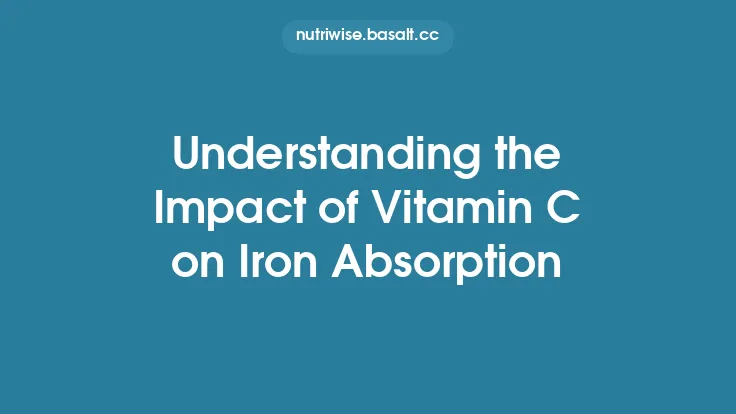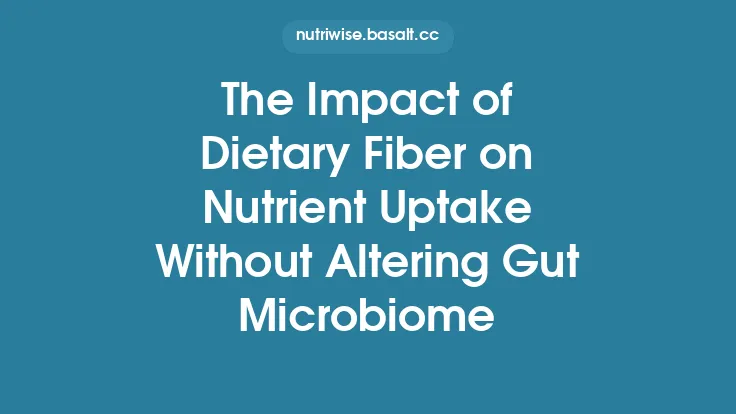The way we combine foods on our plates can dramatically influence how efficiently our bodies extract and utilize the nutrients they contain. While the nutrient composition of individual ingredients is often highlighted, the interactive effects that arise when foods are eaten together—known as food pairings—play an equally crucial role in determining overall nutrient bioavailability. Understanding these interactions helps nutrition professionals, food developers, and everyday cooks design meals that maximize health benefits without relying on supplements or specialized processing techniques.
Mechanisms Underlying Food Pairing Effects
Food pairings affect nutrient absorption through several biochemical and physiological pathways:
- Solubilization and Micelle Formation – Lipid‑soluble nutrients (e.g., vitamins A, D, E, K) require incorporation into mixed micelles in the intestinal lumen before they can cross the enterocyte membrane. Consuming dietary fats provides the necessary bile‑acid‑stimulated micellar environment, dramatically increasing the solubility of these compounds.
- Redox Modulation – Certain phytochemicals act as antioxidants or pro‑oxidants, altering the redox state of the gut lumen. A more reduced environment can preserve labile nutrients such as vitamin C, while a mildly oxidative milieu may facilitate the release of bound minerals.
- pH Alteration – Acidic foods (e.g., citrus fruits, fermented vegetables) lower gastric pH, enhancing the solubility of minerals like non‑heme iron and zinc. Conversely, alkaline foods can neutralize excess acidity, protecting pH‑sensitive nutrients from degradation.
- Enzyme Activation or Inhibition – Some food components stimulate digestive enzymes (e.g., proteases, lipases) while others inhibit them. For instance, the presence of certain organic acids can increase pancreatic lipase activity, improving fat digestion and, consequently, the absorption of fat‑soluble vitamins.
- Transporter Modulation – Nutrient transporters on the enterocyte surface can be up‑ or down‑regulated by specific dietary compounds. Polyphenols, for example, have been shown to influence the expression of the sodium‑dependent vitamin C transporter (SVCT1), affecting ascorbic acid uptake.
These mechanisms often act in concert, meaning that the net effect of a food pairing can be synergistic (enhancing absorption) or antagonistic (impairing absorption).
Enhancing Absorption of Fat‑Soluble Vitamins Through Lipid Co‑Consumption
Fat‑soluble vitamins are among the most sensitive to food pairing because their absorption hinges on the presence of dietary lipids:
- Vitamin A (Retinol and Carotenoids) – Carotenoids such as β‑carotene are poorly absorbed in the absence of fat. Pairing carrot‑rich dishes with oils (olive, canola) or fatty foods (avocado, nuts) can increase micellar incorporation by up to threefold. The type of fat matters; medium‑chain triglycerides (MCTs) form smaller micelles, facilitating more efficient uptake.
- Vitamin E (Tocopherols and Tocotrienols) – Similar to carotenoids, vitamin E requires a lipid matrix for solubilization. Studies demonstrate that adding a modest amount of oil (≈10 g) to a salad containing leafy greens raises plasma tocopherol levels significantly within hours.
- Vitamin K (Phylloquinone and Menaquinones) – Green leafy vegetables are rich in vitamin K1, yet its bioavailability is limited without accompanying fat. A simple drizzle of nut oil or a handful of seeds can double the amount of vitamin K that reaches circulation.
Practical tip: When planning a meal centered on vegetables high in fat‑soluble vitamins, aim for a balanced ratio of 1–2 g of fat per 100 g of vegetable. This modest amount is sufficient to create an optimal micellar environment without adding excessive calories.
Synergistic Interactions Between Polyphenols and Micronutrients
Polyphenols—abundant in fruits, tea, coffee, and cocoa—exhibit complex relationships with micronutrients:
- Vitamin C and Polyphenol‑Rich Foods – Vitamin C is a potent reducing agent that can regenerate oxidized polyphenols, preserving their antioxidant capacity. In turn, polyphenols can protect vitamin C from oxidative degradation during digestion, extending its functional lifespan in the gut.
- Flavonoids and Non‑Heme Iron – While flavonoids are sometimes labeled as iron inhibitors, certain flavonoid structures (e.g., quercetin glycosides) can form soluble complexes with iron that remain bioavailable, especially when paired with vitamin C. This dual action can enhance iron uptake without the need for cooking modifications.
- Catechins and Zinc – Green tea catechins have been observed to increase the expression of zinc transporters (ZIP4) in intestinal cells, potentially improving zinc absorption when tea is consumed alongside zinc‑rich foods like pumpkin seeds.
The key to harnessing these synergies lies in timing and proportion. Consuming polyphenol‑rich beverages or foods within 30 minutes of a micronutrient‑dense meal maximizes the window for interaction, while excessive polyphenol intake (>1 g per meal) may tip the balance toward inhibition.
Impact of Acidic and Alkaline Foods on Mineral and Vitamin Uptake
The gastric environment is a decisive factor for many nutrients:
- Acidic Foods Boost Non‑Heme Iron – Ascorbic acid (vitamin C) and other organic acids (citric, malic) chelate iron, maintaining it in a soluble ferrous (Fe²⁺) state. Pairing iron‑rich plant foods (lentils, spinach) with citrus juice or tomato sauce can increase iron absorption by 2–4 times compared with a neutral pH environment.
- Alkaline Foods Preserve Vitamin B Complex – While the focus of this article is not on B12, other B‑vitamins (e.g., thiamine, riboflavin) are relatively stable at higher pH. Consuming alkaline foods such as leafy greens alongside B‑vitamin‑rich grains can reduce acid‑mediated degradation in the stomach.
- pH‑Dependent Calcium Interactions (Excluded) – Although calcium is a common topic in other articles, it is worth noting that the same pH principles apply to other divalent cations, such as manganese, which benefit from an acidic milieu.
Balancing meal pH can be achieved by incorporating a modest amount of acidic fruit (½ cup of orange segments) or a splash of vinegar into dishes that contain minerals prone to precipitation.
Role of Dietary Fiber in Modulating Nutrient Bioavailability
Dietary fiber is often discussed in the context of gut health, but its influence on nutrient absorption extends beyond microbial fermentation:
- Viscous Soluble Fiber and Micelle Stability – Soluble fibers (e.g., pectin, β‑glucan) increase the viscosity of intestinal contents, which can slow the diffusion of micelles and, paradoxically, prolong the contact time between nutrients and the absorptive surface. This effect has been shown to enhance the uptake of fat‑soluble vitamins when fiber is present in moderate amounts (≈3–5 g per meal).
- Insoluble Fiber as a Physical Carrier – Insoluble fibers (cellulose, hemicellulose) can entrap micronutrients within the food matrix, protecting them from premature oxidation. When the fiber matrix is broken down during mastication, the bound nutrients become more readily available for enzymatic action.
- Fiber‑Induced Dilution of Antinutrients – While phytates and oxalates are not the focus here, fiber can dilute the concentration of these compounds, indirectly improving the relative availability of co‑ingested minerals.
The practical implication is to aim for a balanced fiber profile: combine soluble fiber sources (oats, apples) with insoluble sources (whole‑grain breads, nuts) to create a synergistic environment for nutrient absorption.
Practical Guidelines for Constructing Nutrient‑Optimized Meals
- Start with a Base of Whole Foods – Choose minimally processed vegetables, fruits, legumes, nuts, and whole grains as the foundation of the meal. Their natural matrix provides the structural context for nutrient interactions.
- Add a Targeted Fat Source – Incorporate 1–2 g of healthy fat per 100 g of fat‑soluble‑vitamin‑rich vegetables. Olive oil, avocado, or a handful of seeds are excellent choices.
- Introduce an Acidic Element – A squeeze of lemon, a splash of vinegar, or a side of citrus fruit can lower gastric pH, facilitating mineral solubilization.
- Pair Polyphenol‑Rich Items with Micronutrient‑Dense Foods – Match berries, tea, or cocoa with vitamin C‑rich produce or iron‑containing legumes to exploit synergistic antioxidant and mineral‑enhancing effects.
- Mind the Fiber Balance – Include both soluble and insoluble fiber sources, but avoid excessive fiber (>15 g per meal) which may impede absorption by creating overly viscous chyme.
- Timing Matters – Consume the acidic and polyphenol components within 30 minutes of the main nutrient‑dense dish to maximize interaction windows.
- Portion Control of Inhibitory Compounds – While some compounds (e.g., tannins) can hinder absorption at high concentrations, moderate amounts are generally safe and may even provide health benefits.
By following these steps, meals become more than the sum of their parts, turning everyday cooking into a strategic tool for enhancing nutrient bioavailability.
Future Directions in Food Pairing Research
The field of nutrient bioavailability is rapidly evolving, and several promising avenues are emerging:
- Omics‑Driven Pairing Models – Integrating metabolomics and nutrigenomics data can predict how specific food combinations influence gene expression related to nutrient transporters and metabolic pathways.
- Personalized Pairing Algorithms – Machine‑learning platforms that consider individual genetic variants (e.g., polymorphisms in the NPC1L1 cholesterol transporter) could recommend tailored food pairings to optimize absorption for each person.
- Dynamic In‑Vitro Digestion Systems – Advanced gut simulators that mimic peristalsis, pH shifts, and enzyme secretions allow researchers to test complex meal matrices in real time, providing more accurate predictions of in‑vivo absorption.
- Food Structure Engineering – Manipulating the physical architecture of foods (e.g., through 3D printing or controlled particle size) may enhance the release and interaction of nutrients during digestion.
- Cross‑Cultural Pairing Studies – Traditional cuisines often embody empirically derived food pairings (e.g., legumes with citrus). Systematic investigation of these cultural practices can uncover novel synergistic combinations.
Continued interdisciplinary collaboration among nutrition scientists, food technologists, and data analysts will be essential to translate these insights into practical dietary recommendations.
In summary, the strategic pairing of foods influences nutrient absorption through a web of biochemical mechanisms, ranging from micelle formation to pH modulation and transporter regulation. By consciously designing meals that incorporate complementary fats, acids, polyphenols, and balanced fiber, we can unlock the full nutritional potential of everyday foods, fostering better health outcomes without reliance on fortified products or complex cooking techniques.





